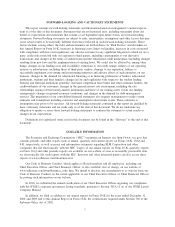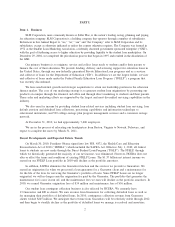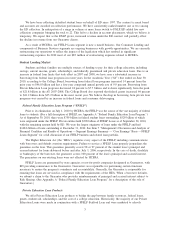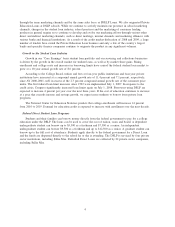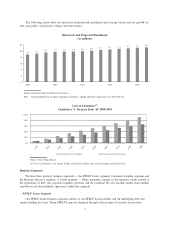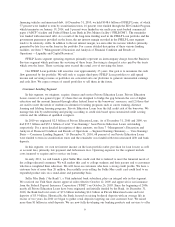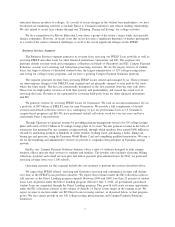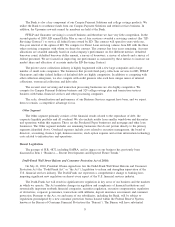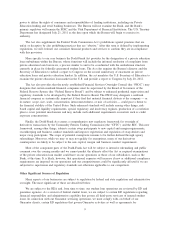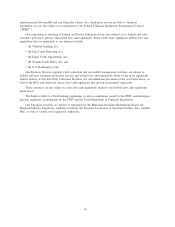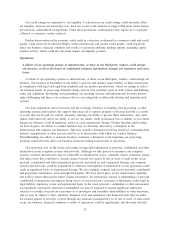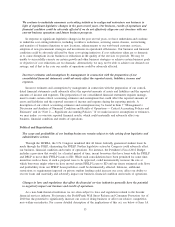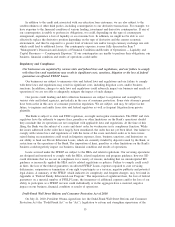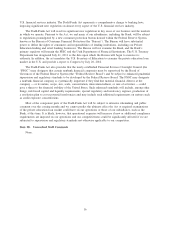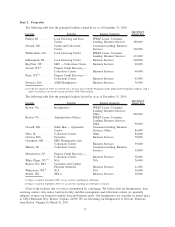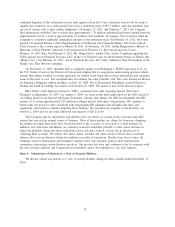Sallie Mae 2010 Annual Report Download - page 12
Download and view the complete annual report
Please find page 12 of the 2010 Sallie Mae annual report below. You can navigate through the pages in the report by either clicking on the pages listed below, or by using the keyword search tool below to find specific information within the annual report.Item 1A. Risk Factors
Our business activities involve a variety of risks. Below we describe the significant risk factors affecting
our business. The risks described below are not the only risks facing us — other risks also could impact our
business.
Funding and Liquidity.
Our business is affected by funding constraints in the capital markets and the interest rate characteristics
of our earning assets do not always match the interest rate characteristics of our funding arrangements.
These factors may increase the price of or decrease our ability to obtain liquidity as well expose us to
basis and repricing risk.
The capital markets have experienced and continue to experience a prolonged period of volatility. This
volatility has had varying degrees of impact on most financial organizations, including us. These conditions have
affected our access to and cost of capital necessary to manage and effectively operate our business. Additional
factors that could make financing difficult, more expensive or unavailable on any terms include, but are not
limited to, our financial results and losses, changes within our organization, events that have an adverse impact on
our reputation, changes in the activities of our business partners, events that have an adverse impact on the
financial services industry, counterparty availability, changes affecting our assets, corporate and regulatory actions,
absolute and comparative interest rate changes, ratings agencies’ actions, general economic conditions and the
legal, regulatory, accounting and tax environments governing our funding transactions. If financing becomes more
difficult, expensive or unavailable, our business, financial condition and results of operations could be materially
and adversely affected.
In recent years, the ongoing volatility and illiquidity of the capital markets has caused the U.S. Federal
government to intervene and provide various forms of financial assistance and liquidity programs to numerous
industries, including the student loan industry. Our participation in these programs provided significant
liquidity for us at times when capital market alternatives were of limited availability or borrowing costs were
otherwise excessive. Given current Federal budgetary constraints and recent congressional actions that have
affected the student loan industry, there can be no assurance that these types of financial assistance and
liquidity programs will again be made available if volatility and illiquidity of the capital markets were to
increase or continue for a prolonged period of time.
During 2010, we funded Private Education Loan originations primarily through term brokered and retail
deposits raised by the Bank. Assets funded in this manner result in re-financing risk because the average term
of the deposits is shorter than the expected term of some of the same assets. There is no assurance that this or
other sources of funding, such as the term asset-backed securities market, will be available at a level and a
cost that makes new Private Education Loan originations possible or profitable, nor is there any assurance that
the loans can be re-financed at profitable margins. For additional discussion on regulatory and compliance
risks relating to the Bank, see below at Item 1A “Risk Factors — Regulatory and Compliance.” If we were
unable to obtain funds from which to make new Private Education Loans our business, financial condition and
results of operations would be materially and adversely affected.
The interest rate characteristics of our earning assets do not always match the interest rate characteristics
of our funding arrangements. This mismatch exposes us to risk in the form of basis risk and repricing risk.
While most of such basis risks are hedged using interest rate swap contracts, such hedges are not always
perfect matches and, therefore, may result in losses. Moreover, it may not always be possible to hedge all of
our exposure to such basis risks. While the asset and hedge indices are short-term with rate movements that
are typically highly correlated, there can be no assurance that the historically high correlation will not be
disrupted by capital market dislocations or other factors not within our control. In such circumstances, our
earnings could be adversely affected, possibly to a material extent. For instance, as a result of the turmoil in
the capital markets, the historically tight spread between CP (the index used for many of our assets) and
LIBOR (the index used for much of our debt) began to widen dramatically in the fourth quarter of 2008
resulting in substantial increases in our cost of funds. The spread subsequently returned to historical levels
beginning in the third quarter of 2009 and has been stable since then.
11


